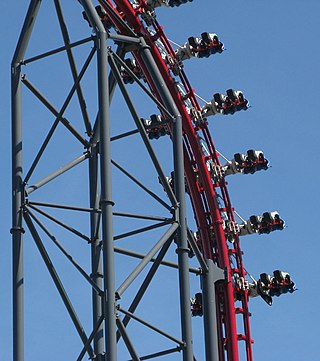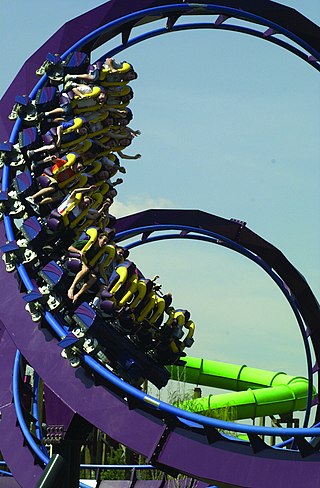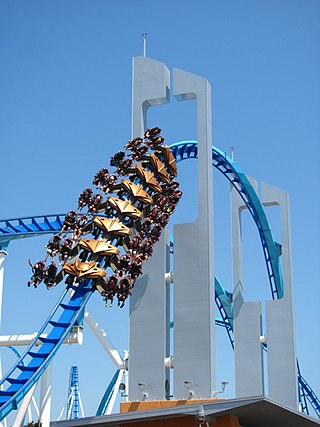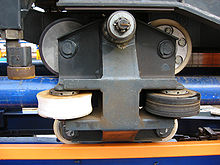Design
On modern roller coasters, both wooden and steel, the same basic design of wheel assembly is found. Each wheel assembly typically consists of at least 3 wheels per assembly arranged in 3 positions: top, side, and under the rails, known as "running wheels", "side friction wheels", and "up-stop wheels", respectively. Most modern roller coasters typically have pairs of wheels in each orientation, with 6 wheels per assembly, but this can vary by ride. The up-stop system was developed in 1919 by John A. Miller. He patented a design to make Pleasure-Railway attractions safer. His design consisted of wheels underneath the rails, keeping the train on the track rather than relying on gravity, which allowed more aggressive inclines and a more thrilling ride.
Most roller coasters have some form of up-stop system that runs underneath the rails. They are commonly wheels, but some older roller coasters or low-intensity, family focused rides may utilize a steel plate or bar positioned under the rails due to low forces. Up-stop wheels keep the train from lifting off of the track while traversing hills that may provide negative g-forces, or through inversions. They are typically the smallest wheels out of the assembly.
Side friction wheels hug the sides of the rail, either the outside or inside, depending on the ride manufacturer. Early Arrow Dynamics steel roller coasters oriented the side frictions wheels on the inside of the rails. Side friction wheels keep the train centered in the track, avoiding derailment.
The final set of wheels in the assembly are known as running wheels, road wheels, or tractor wheels. Running wheels are typically the largest set of wheels in the assembly, and roll on the top of the rails. These wheels bear the weight of the train. They are typically made from a polyurethane or nylon/polyurethane blend, [1] while side friction and up-stop wheels can be made of the same materials or steel. Some older wooden roller coasters utilize steel wheels throughout the assembly. The benefits of the polyurethane or nylon/polyurethane blend are low rolling resistance, high load endurance, smooth ride, and high durability. [2]
Some manufacturers' coasters have a larger gap between the up-stop and/or side friction wheels and the track. In instances of negative g-force or through inversions, the road wheels may lift off the track slightly until the up-stop wheels engage. This can result in a rougher ride. As technology has improved, the gap has been significantly lessened or eliminated, resulting in smoother rides.

A roller coaster, or rollercoaster, is a type of amusement ride that employs a form of elevated railroad track designed with tight turns, steep slopes, and sometimes inversions. Passengers ride along the track in open cars, and the rides are often found in amusement parks and theme parks around the world. LaMarcus Adna Thompson obtained one of the first known patents for a roller coaster design in 1885, related to the Switchback Railway that opened a year earlier at Coney Island. The track in a coaster design does not necessarily have to be a complete circuit, as shuttle roller coasters demonstrate. Most roller coasters have multiple cars in which passengers sit and are restrained. Two or more cars hooked together are called a train. Some roller coasters, notably Wild Mouse roller coasters, run with single cars.

A wooden roller coaster is a type of roller coaster classified by its wooden track, which consists of running rails made of flat steel strips mounted on laminated wood. The support structure is also typically made of wood, but may also be made of steel lattice or truss, which has no bearing on a wooden coaster's classification. The type of wood often selected in the construction of wooden coasters worldwide is southern yellow pine, which grows abundantly in the southern United States, due to its density and adherence to different forms of pressure treatment.

An inverted roller coaster is a roller coaster in which the train runs under the track with the seats directly attached to the wheel carriage. This latter attribute is what sets it apart from the older suspended coaster, which runs under the track, but swings via a pivoting bar attached to the wheel carriage. The coaster type's inverted orientation, where the passengers' legs are exposed, distinguishes it from a traditional roller coaster, where only the passengers' upper body parts, including the arms, are exposed.

A stand-up roller coaster is a roller coaster designed to have the passengers stand through the course of the ride.

Bolliger & Mabillard, officially Bolliger & Mabillard Consulting Engineers, Inc. and often abbreviated B&M, is a roller coaster design consultancy based in Monthey, Switzerland. The company was founded in 1988 by engineers Walter Bolliger and Claude Mabillard, both of whom had worked for Giovanola.

Arrow Dynamics was an American manufacturing and engineering company that specialized in designing and building amusement park rides, especially roller coasters. Based in Clearfield, Utah, the company was the successor to Arrow Development (1946–1981) and Arrow Huss (1981–1986), which were responsible for several influential advancements in the amusement and theme park industries. Among the most significant was tubular steel track, which provided a smoother ride than the railroad style rails commonly used prior to the 1960s on wooden roller coasters. The Matterhorn Bobsleds at Disneyland, built in 1959, was Arrow's first roller coaster project.

A Floorless Coaster is a type of steel roller coaster manufactured by Bolliger & Mabillard where riders sit with no floor underneath them, allowing their feet to swing freely just above the track. Development of the Floorless Coaster model began between 1995 and 1996 with Medusa at Six Flags Great Adventure opening on April 2, 1999, making it the world's first Floorless Coaster. Floorless Coasters also tend to have 3 to 7 inversions incorporated in the layout of the coaster.

A lift hill, or chain hill, is an upward-sloping section of track on a roller coaster on which the roller coaster train is mechanically lifted to an elevated point or peak in the track. Upon reaching the peak, the train is then propelled from the peak by gravity and is usually allowed to coast throughout the rest of the roller coaster ride's circuit on its own momentum, including most or all of the remaining uphill sections. The initial upward-sloping section of a roller coaster track is usually a lift hill, as the train typically begins a ride with little speed, though some coasters have raised stations that permit an initial drop without a lift hill. Although uncommon, some tracks also contain multiple lift hills.
A brake run on a roller coaster is any section of track meant to slow or stop a roller coaster train. Brake runs may be located anywhere along the circuit of a coaster and may be designed to bring the train to a complete halt or to simply adjust the train's speed. Contrary to some belief, the vast majority of roller coasters do not have any form of braking on the train itself, but rather forms of braking that exist on track sections. One notable exception is the Scenic Railway roller coaster, which relies on an operator to manually control the speed of the train.

The launched roller coaster is a modern form of roller coaster. A launched coaster initiates a ride with high amounts of acceleration via one or a series of linear induction motors (LIM), linear synchronous motors (LSM), catapults, tires, chains, or other mechanisms employing hydraulic or pneumatic power, along a launch track. This mode of acceleration powers many of the fastest rollercoasters in the world.
A side friction roller coaster is an early roller coaster design invented by Edward Joy Morris. The design introduced side-friction wheels to help prevent trains from derailing during curved portions of the track. In addition to weight-bearing wheels traditionally located on the underside of each train car, friction wheels were added to both sides, which roll perpendicular along the inner edge of the track.

Nemesis is an inverted roller coaster located at the Alton Towers theme park in England. Manufactured by Bolliger & Mabillard, the ride was designed by Werner Stengel in collaboration with attraction developer John Wardley. It opened in the Forbidden Valley area of the park on 19 March 1994.

A fourth-dimension roller coaster is a type of steel roller coaster whereby riders are rotated independently of the orientation of the track, generally about a horizontal axis that is perpendicular to the track. The carts do not necessarily need to be fixed to an angle.

Batman: The Dark Knight is a steel floorless roller coaster designed by Bolliger & Mabillard located in the Gotham City section of Six Flags New England. The roller coaster has 2,600 feet (790 m) of track, reaches a maximum height of 117.8 feet (35.9 m) and features five inversions. The coaster was announced on February 6, 2002 and opened to the public on April 20, 2002. In 2008, the ride's name was changed to Batman: The Ride to avoid confusion with Six Flags New England's installation of The Dark Knight Coaster that was planned to be built at the park; but after the project was cancelled, the ride's name reverted to Batman: The Dark Knight.

Goliath is an inverted roller coaster located at Six Flags Fiesta Texas in San Antonio, Texas, United States. Designed by Werner Stengel and Swiss manufacturer Bolliger & Mabillard, Goliath initially opened in 1995 at an amusement park in Japan, and has been operating at Six Flags Fiesta Texas since 2008. It stands at a height of 105 feet (32 m), reaches a maximum speed of 50 mph (80 km/h), and features multiple inversions.
The physics of roller coasters comprises the mechanics that affect the design and operation of roller coasters, a machine that uses gravity and inertia to send a train of cars along a winding track. Gravity, inertia, g-forces, and centripetal acceleration give riders constantly changing forces which create certain sensations as the coaster travels around the track.

Wing Coaster is engineering firm Bolliger & Mabillard’s designation for its winged roller coaster designs. Winged roller coasters are a type of steel roller coaster where pairs of riders sit on either side of a roller coaster track in which nothing is above or below the riders. B&M began development on the first Wing Coaster between 2007 and 2008 leading to the opening of Raptor at Gardaland on 1 April 2011. There were sixteen B&M-designed Wing Coasters either under construction or operating worldwide as of December 2020.

SheiKra is a steel Dive Coaster roller coaster at the Busch Gardens Tampa Bay amusement park in Tampa, Florida, United States. The roller coaster was proposed by Mark Rose, vice-president of design and engineering for the park, and designed by Bolliger & Mabillard. The ride was planned to be 160 feet (49 m) high, but the park's executives rejected this and the height was changed to 200 feet (61 m). SheiKra reaches a maximum speed of 70 miles per hour (110 km/h) and has a total track length of 3,188 feet (972 m). It first opened on May 21, 2005, and was converted to a floorless roller coaster on June 16, 2007, following the opening of its sister Dive Coaster Griffon at Busch Gardens Williamsburg that year.

Thunderbird is a steel roller coaster in the Thanksgiving section of Holiday World & Splashin' Safari amusement park in Santa Claus, Indiana. Designed by Bolliger & Mabillard, the ride opened in 2015 as the eighth Wing Coaster in the world and the fourth in the United States.

















